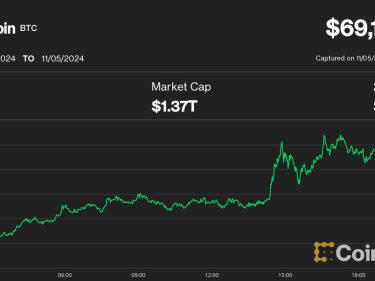Don’t Tell Anyone, but Private Blockchains Handle Over $1.5T of Securities Financing a Month
Financial technology consultancy Broadridge says it handles $50 billion a day of repurchase agreements involving big banks on its permission-only DLR platform.
Europe-focused securities finance private blockchain firm HQLAx says its platform can save banks as much as 100 million euros ($107 million) a year.
The multitrillion-dollar repo market is the lifeblood of funding in capital markets.
Tokenization enthusiasts in both crypto and traditional finance might be surprised to hear that well over $1.5 trillion worth of repurchase agreements and other forms of securities financing are executed monthly using private blockchains.
While this is a sliver of a highly fragmented, multitrillion-dollar market, these private blockchain loops are being employed at a decent scale by many of the world’s biggest banks and institutions, easily dwarfing the much-hyped tokenization of real-world assets (RWA) associated with open chains like Ethereum.
Indeed, it could be argued these permission-based, under-the-radar repo ledgers are some of the most successful applications of blockchain technology in existence because repo – where cash is borrowed against securities, often highly liquid Treasuries, with an agreed buy-back date and price – is the lifeblood of funding in capital markets.
Wall Street titans like JPMorgan and Goldman Sachs are reluctant to share specific data when it comes to areas like repo trading. JPMorgan reportedly processes up to $2 billion of transactions a day on its Onyx blockchain, which allows its clients to “settle repo transactions worth billions of dollars within minutes, using smart contracts to tokenize and deliver cash and collateral on a single ledger,” Nikhil Sharma, head of growth at Onyx Digital Assets, said in an email.
There’s more visibility into the hundreds of billions in live repo transactions some of the systemically important banks are aggregating on tech consultancy Broadridge’s Distributed Ledger Repo (DLR) platform, which handles $50 billion in repo volume a day and is used by the likes of Societe Generale, UBS, HSBC and Chicago-based trading giant DRW. Another prominent player is Europe-focused HQLAx (the acronym is for high-quality liquid assets).
As well as clocking up significant volume, these platforms are also building cross-chain interoperability and integrating bank-grade cash settlement tokens. Last week, HQLAx, which is built using R3’s enterprise-grade Corda ledger and includes HSBC, BNY Mellon and Goldman on its platform, completed a delivery versus payment (DvP) repo settlement with London-based startup Fnality, a provider of institutional-grade digital cash built on a permissioned version of Ethereum.
Last month, Broadridge’s DLR, built using Canton Protocol, a smart-contract ledger created by Digital Asset, became interoperable with JPMorgan’s JPM Coin, which also runs on a privacy-focused fork of Ethereum. DLR is also used Commerzbank, with more banks soon to be named.
“Working with JPM Coin, on the cash side, is probably the largest digital-cash initiative in the world, and we are probably the largest collateral initiative in the world,” said Horacio Barakat, head of digital innovation at Broadridge, in an interview. “So working together towards that interoperability is very important.”
Goldman Sachs’ global head of digital assets, Mathew McDermott, points to inefficiencies in conventional repo and securities lending markets brought about by years of layering and fragmentation.
“DLT has the potential to significantly improve existing processes and create new markets like intraday repo and intraday FX so it’s fantastic to see the success of platforms such as Broadridge’s DLR and HQLAx as they continue to grow and scale,” McDermott said in an email, using an acronym of digital ledger technology.
To those involved in securities financing, blockchain has always looked like a killer application. An “incredible spaghetti mess” is how HQLAx CEO Guido Stroemer describes the vast tangle of securities that need to be physically moved around so big banks can meet their collateral obligations. This complexity leads to banks buying expensive excess collateral buffers, dealing with occasional settlement failures and time lags that result in intraday counterparty credit exposure.
“We believe that relieving those headwinds can save banks between 50 million euros ($54 million) and 100 million euros per year, and we actually think that’s conservative,” Stroemer said in an interview. “We can enable the banking industry to transfer ownership of securities to the collateral obligation of choice, without actually moving them from the custody locations where they are.”
Stroemer expects HQLAx volumes to reach into the high tens of billions by the end of the year. “We have a very strong pipeline of volumes that institutions are planning on putting on the platform. Over time, we expect to have a market share of roughly 400 billion euros to 500 billion euros of activity that stays on the platform,” he said.
Given that tokenization is firmly entrenched in the crypto mindset, it will be interesting to see how these closed loops feed into the public blockchain meets TradFi narrative. Although it primarily flies under the radar, Broadridge’s intraday repo business may have the best product market fit in all of the tokenization space, said Rob Hadick, general partner at VC firm Dragonfly.
“These types of on-chain products are going to become the norm for Wall Street,” Hadick said in an interview. “That said, it’s unclear how this might translate into any value accrual for public chains and the broader crypto economy. There’s an argument that it could be a ‘gateway drug,’ so-to-speak, but that requires a lot of belief.”
Yes, there could be a transformative scenario where native securities are issued on a public network and settled with open digitized cash, said Broadridge’s Barakat. But, he said, that requires regulatory changes, and there’s the natural risk aversion that comes with incorporating new technology, particularly something as disruptive as using a public blockchain for transacting repo.
“If you wait for that to happen, then you miss out on a lot of the immediate opportunities that are there today, which is where private and semi-private networks are popping up,” Barakat said.




